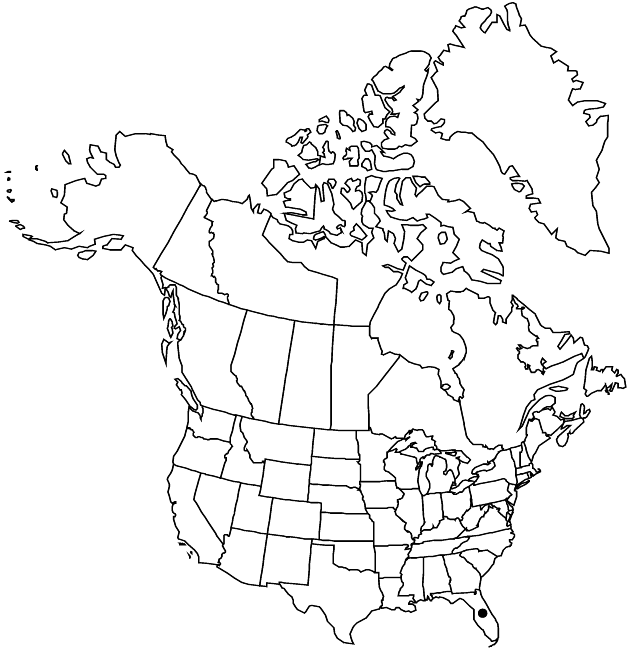Difference between revisions of "Liatris provincialis"
Amer. Midl. Naturalist 66: 466, fig. 1. 1961.
FNA>Volume Importer |
FNA>Volume Importer |
||
| Line 25: | Line 25: | ||
|distribution=Fla. | |distribution=Fla. | ||
|discussion=<p>Of conservation concern.</p><!-- | |discussion=<p>Of conservation concern.</p><!-- | ||
| − | --><p>Liatris provincialis is very similar to L. chapmanii and apparently restricted to coastal and near-coastal sites in panhandle of Florida (Franklin and Wakulla counties). Beside the difference in orientation of the heads, phyllaries of L. provincialis are broader (versus gradually and more narrowly lanceolate), often abruptly acute to short-acuminate or cuspidate, but there is little else to distinguish the two. Liatris provincialis is in the Center for Plant Conservation’s National Collection of Endangered Plants.</p> | + | --><p><i>Liatris provincialis</i> is very similar to <i>L. chapmanii</i> and apparently restricted to coastal and near-coastal sites in panhandle of Florida (Franklin and Wakulla counties). Beside the difference in orientation of the heads, phyllaries of <i>L. provincialis</i> are broader (versus gradually and more narrowly lanceolate), often abruptly acute to short-acuminate or cuspidate, but there is little else to distinguish the two. <i>Liatris provincialis</i> is in the Center for Plant Conservation’s National Collection of Endangered Plants.</p> |
|tables= | |tables= | ||
|references= | |references= | ||
| Line 49: | Line 49: | ||
|publication year=1961 | |publication year=1961 | ||
|special status= | |special status= | ||
| − | |source xml=https://jpend@bitbucket.org/aafc-mbb/fna-data-curation.git/src/ | + | |source xml=https://jpend@bitbucket.org/aafc-mbb/fna-data-curation.git/src/8f726806613d60c220dc4493de13607dd3150896/coarse_grained_fna_xml/V19-20-21/V21_1336.xml |
|tribe=Asteraceae tribe Eupatorieae | |tribe=Asteraceae tribe Eupatorieae | ||
|genus=Liatris | |genus=Liatris | ||
Revision as of 15:31, 18 September 2019
Plants 45–90 cm. Corms globose to elongate. Stems hirtellous. Leaves: basal and proximal cauline 1-nerved, linear-oblanceolate to narrowly oblanceolate, 60–150 × 2–6 mm, abruptly reduced, linear, 1–2 mm wide, then gradually or little reduced distally, essentially glabrous or hirtellous (sometimes mostly along abaxial midveins), gland-dotted. Heads in dense, spiciform arrays (spreading to ascending, not strongly overlapping). Peduncles 0. Involucres cylindric, 9–11 × 3–5 mm. Phyllaries in 3–4(–5) series, oblong-obovate to oblong or oblong-lanceolate, strongly unequal, glabrous, sparsely puberulent, or hirtellous, margins with hyaline borders, ciliolate, apices acute to acuminate (mid often cuspidate). Florets 3–4; corolla tubes glabrous inside. Cypselae 4–5.5 mm; pappi: lengths ± equaling corollas, bristles barbellate.
Phenology: Flowering (Aug–)Sep–Oct.
Habitat: Evergreen oak-sand pine-scrub, turkey oak-longleaf pine, sand ridges, dunes
Elevation: 0–10 m
Discussion
Of conservation concern.
Liatris provincialis is very similar to L. chapmanii and apparently restricted to coastal and near-coastal sites in panhandle of Florida (Franklin and Wakulla counties). Beside the difference in orientation of the heads, phyllaries of L. provincialis are broader (versus gradually and more narrowly lanceolate), often abruptly acute to short-acuminate or cuspidate, but there is little else to distinguish the two. Liatris provincialis is in the Center for Plant Conservation’s National Collection of Endangered Plants.
Selected References
None.
